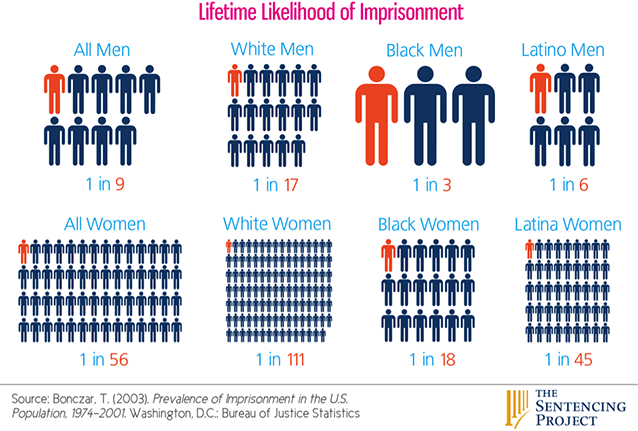The War on Drugs and Mass Incarceration 
No discussion of civil rights for blacks can be complete without addressing the issue of mass incarceration. While this complicated issue has roots as far back as the end of the Civil War, it was exacerbated by the policies put in place by President Reagan and Congress when they declared a war on drugs. Those policies were maintained by Bush and intensified by the crime bill passed in 1994 by President Clinton. It was only in George W. Bush's second term that the sentencing disparity between crack cocaine and powder cocaine was finally addressed by the Supreme Court. Even still, a disparity in sentencing between the two drugs remains, despite the fact that they have been determined to be almost the same substance.
Misguided drug laws and draconian sentencing requirements, especially pertaining to crack cocaine, have produced profoundly unequal outcomes for communities of color. The results have decimated minority families - black men in particular have been victims of these policies. Although rates of drug use and selling are comparable across racial and ethnic lines, blacks and Latinos are far more likely to be criminalized for drug law violations than whites. Although minorities use and sell drugs at a similar rate as whites, the proportion of those incarcerated in state prisons for drug offenses who are black or Latino is 57 percent.
Notable Supreme Court Cases:
- United States v. Booker, 543 U.S. 220 (2005) - this case held that the sentencing guidelines, which had been mandatory, were instead advisory and that courts needed to look to the history and characteristics of defendants when determining sentence lengths.
- Kimbrough v. United States, 552 U.S. 85 (2007) - this case took the holding in Booker and applied it specifically to crack cocaine versus powder cocaine sentencing guidelines. There was a huge discrepancy in the sentencing of crack cocaine dealers/users versus dealers/users of powder cocaine (the 100-to-1 ratio) and this case confirmed judges were free to use their discretion when sentencing defendants in crack cocaine cases.

Selected Library Resources:
- Michelle Alexander, The New Jim Crow: Mass Incarceration in the Age of Colorblindness, HV9950 .A437 2010
- Elizabeth Kai Hinton, From the War on Poverty to the War on Crime: The Making of Mass Incarceration in America, HV9950 .H56 2016 (available from the Founders Library Auxiliary Stacks), also available as an ebook
- Linda F. Williams, The Constraint of Race: Legacies of White Skin Privilege in America, E185.61 .W7365 2003
- Doris Marie Provine, Unequal Under Law: Race in the War on Drugs, KF4755 .P76 2007
- Mary E. Patillo et al., Imprisoning America: the Social Effects of Mass Incarceration, HV8705 .I455 2004
- Mona Pauline Lynch, Hard Bargains: the Coercive Power of Drug Laws in Federal Court, KF3890 .L96 2016
- Alexandra Natapoff, Punishment Without Crime: How Our Massive Misdemeanor System Traps the Innocent and Makes America More Unequal, KF9300 .N38 2018
- Jonathan Birnbaum and Clarence Taylor, Civil Rights since 1787: A Reader on the Black Struggle, E184.6 .C595 2000
Additional Resources: